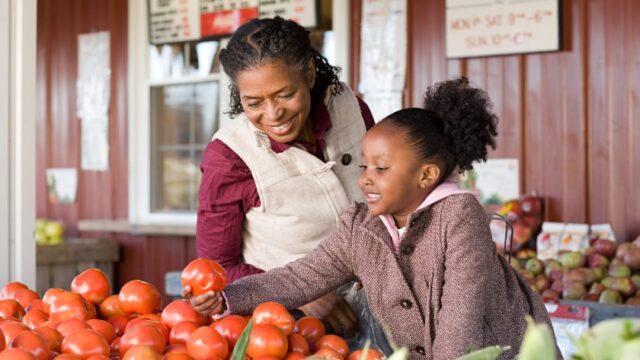Tip Sheet
Promising Practices for Ensuring Kinship/Grandfamily Access to SNAP
Download This Resource


The Supplemental Nutrition Assistance Program (SNAP) plays a vital role in reducing hunger, malnutrition, and poverty and improving family economic security, child and adult health, employment, and other social determinants of health. The program is an essential support for eligible kinship/grandfamilies, but too many eligible kinship/ grandfamilies are missing out on this important nutrition support.
“Kinship/grandfamilies” is a term that refers to families in which grandparents, other relatives, or close family friends are raising children whose parents are unable to do so.

Only 42 percent of grandparent-headed households with grandchildren under age 18 and no parent present and with low incomes participated in SNAP in 2019.
Fortunately, there are key ways that stakeholders – including SNAP advocates, kinship advocates, SNAP agency staff, and lawmakers – can work to ensure that more eligible kinship/grandfamilies are connected to SNAP. This fact sheet highlights opportunities related to policy, outreach, and partnership that should be leveraged to expand SNAP access and maximize benefits for kinship/grandfamilies.
SNAP (which may be called something else, depending on the jurisdiction) is available to eligible kinship/grandfamilies with low incomes in every state, the District of Columbia, Guam, and the U.S. Virgin Islands, and on tribal lands. SNAP households receive monthly benefits on an Electronic Benefits Transfer (EBT) card – which works like a debit card – to purchase food. SNAP allows participants to buy the foods that are right for them at grocery stores, corner stores, farmers’ markets, and other participating food retailers. There are no caps on participation or waitlists, so all eligible kinship/grandfamilies can apply for and participate in SNAP. Households can participate in SNAP and other food programs, including the Special Supplemental Nutrition Program for Women, Infants, and Children (WIC); school meals; senior meals; home-delivered meals; and the Commodity Supplemental Food Program at the same time. Households cannot participate in SNAP and the Food Distribution Program on Indian Reservations at the same time. For more background on SNAP, see the Grandfamilies & Kinship Support Network’s Supplemental Nutrition Assistance Program (SNAP) for Kinship/Grandfamilies, produced in partnership with the Food Research & Action Center (FRAC).
Policies
SNAP is administered by the United States Department of Agriculture (USDA) and by the SNAP agency in the state or territory (often referred to as “SNAP state agencies” even when it applies to the agency in a territory). SNAP state agencies operate in all 50 states, the District of Columbia, Guam, and the U.S. Virgin Islands. Currently, tribal governments do not have the right to administer SNAP. SNAP state agencies are required to consult with Indian Tribal Organizations about the implementation and operation of SNAP on reservations. People who live on tribal lands should apply through the SNAP agency in the relevant jurisdiction.
States and territories should implement policy opportunities to enhance SNAP access and benefits for kinship/grandfamilies. There are policy options and waivers that SNAP agencies can opt into, and policy changes that governments can enact.
SNAP Agency Options
Federal eligibility rules provide income and resource limits on SNAP eligibility but allow SNAP agencies to adopt or apply for a variety of policy options and waivers to vary those rules. These options and waivers (typically referred to as “state options”) can expand program access to more kinship/grandfamilies. Key policy opportunities for SNAP agencies to pursue include the options outlined below.
Broad-Based Categorical Eligibility (BBCE)
BBCE allows SNAP agencies to lift the income eligibility threshold from 130 percent to up to 200 percent of the federal poverty level. It also allows SNAP agencies to remove or adopt less restrictive asset tests so that households can have modest savings without losing SNAP. For more information on increasing the gross income limit and removing the asset test, see FRAC’s Best Practices for Raising the SNAP Gross Income Threshold Through Categorical Eligibility and FRAC’s Best Practices for Eliminating the Asset Test in SNAP Through Broad-Based Categorical Eligibility.
This hypothetical example of Mary, a grandparent caregiver, illustrates the importance of BBCE: Mary is 62 years old and is raising her three grandchildren. Mary makes $48,000 per year. If she resides in Michigan, she may qualify for SNAP benefits through BBCE, as Michigan’s gross income limit is 200 percent of the federal poverty limit (FPL). However, if she resides in Indiana, she would be ineligible due to her income exceeding the 130 percent FPL limit in place in that state. Michigan’s BBCE policy allows SNAP to be more accessible.
Telephonic Signature
The use of telephonic signature helps to streamline the application process for both SNAP applicants and SNAP agencies. The SNAP agency can provide SNAP applicants with the option to “sign” their applications using telephonic signature or a “verbal assent” that is retrievable and connected to the individual’s application. Telephonic signature processes must safeguard the applicant’s identity and privacy.
Elderly Simplified Application Project (ESAP)
ESAP is a demonstration project that streamlines the application and certification process for households that do not have earned income and in which all adult members are aged 60 or older and/or have a disability. ESAP simplifies the application and verification process, provides 36-month certifications, and waives the recertification interview. As of fiscal year 2024, more than 22 states and the District of Columbia have ESAP projects.
Standard Medical Deduction (SMD)
An SMD demonstration project streamlines the process for deducting out-of-pocket medical expenses from the household net income of individuals aged 60 and older and people with disabilities. This can help simplify the process for households and boost SNAP benefit amounts. Instead of documenting each individual medical expense, which can be difficult and time-consuming, eligible households can claim the SNAP agency’s SMD. Applicants still must confirm the first $35 in medical expenses. If an applicant has out-of-pocket medical expenses exceeding the SMD, the SNAP agency can allow applicants to claim the higher amount as long as each expense is confirmed. For more information on the SMD, see FRAC’s report on The SNAP Standard Medical Deduction for Older Adults and People with Disabilities.
See USDA’s SNAP State Options Report to learn about what options are currently being utilized by each SNAP agency.
State Policies
In recent years, several states have recognized the need for additional supports for households and invested state funds to boost SNAP benefits amounts. These funds – which are often targeted to households with older adults – help to boost the minimum SNAP benefits. Some states also provide state-funded SNAP-like benefits for certain immigrant groups. While ultimately the most sustainable solutions are to increase SNAP benefits federally, these state investments are essential supports for households.
State-Funded SNAP Boosts
Since 2016, Maryland has invested in a state-funded SNAP benefit increase that boosts the minimum monthly benefit for older adult households. For fiscal year 2025, the federal minimum benefit is $23 for households with one person or two people. Thanks to the state-funded boost, the minimum benefit for Maryland SNAP households with a member aged 60 or older is $50 per month.
Since 2023, New Jersey has used state funding to boost their minimum SNAP benefit for all households to $95 per month. If a household is eligible for less than that amount in federal SNAP benefits, the state will use state funds to raise the household’s benefit up to $95. This is an increase from the previous state-funded minimum of $50, which passed in 2022.
In June 2024, SNAP participants in New Mexico who were aged 60 or older or had disabilities received a boost in benefits. Thanks to state funding, eligible SNAP participants got an additional $135 in one-time SNAP benefits.
Outreach and Application Assistance
Reaching kinship/grandfamilies with accurate information on SNAP – including eligibility, how to access the program, and the many benefits of participation – and application assistance is essential to connecting more families to this important program and ensuring they receive the full benefit for which they are eligible.
Leverage SNAP State Outreach Plans
SNAP agencies and their community nonprofit and local government partners can receive matching federal funds to create and implement SNAP outreach and application assistance plans. The federal funds cover up to 50 percent of the cost of approved activities and can help agencies to reach households that are eligible but not participating in SNAP. SNAP agencies and community partners can seek matching funds from a variety of private and public sources, e.g., private foundations, food retailers, business or labor partners, private donors, and local or state governments. State SNAP agencies must submit plans for USDA approval.
To help shape outreach, the USDA releases memos that designate outreach priority areas. The FY 2025 memo urged SNAP agencies to strengthen partnerships and outreach to reach more SNAP-eligible older adults and specifically mentions “kinship caregivers.” This provides a prime opportunity for SNAP agencies and their partners to conduct targeted outreach to connect more kinship/grandfamilies to SNAP.
Create Resources and Messaging Tailored to Kinship/Grandfamilies
Many eligible households may not be benefiting from SNAP due to a lack of accurate program information or misinformation. Resources on SNAP targeted to kinship/ grandfamilies can help educate families and organizations that serve them about SNAP.
Hunger Solutions New York has resources on federal nutrition programs tailored to kinship/grandfamilies. This user-friendly kinship care flyer gives top line information on SNAP and other key federal nutrition programs and shares how to learn more and apply.
Tailored resources can help to spread awareness about the program generally, as well as lift up key facets of SNAP that are particularly helpful to kinship/grandfamilies. For example, it might be especially helpful for a kinship/grandfamily to know:
- A household for SNAP purposes includes all people who live, buy, and prepare meals together. People do not need to be related or have a legal relationship to be considered a SNAP household, so a caregiver does not need to have legal custody or guardianship, or be related to, the child living with them in order to receive SNAP.
- There are special rules for children in foster care (in the legal custody of child welfare), whether with kin or not. Children in foster care can be included or excluded from the household unit applying for SNAP at the discretion of the household applying. If a child in foster care is included in the household for SNAP benefits, then any foster care payments the family receives are considered income when determining SNAP benefits. If a child in foster care is not included in the SNAP household, then the foster payments are excluded from income. Children in foster care cannot participate in SNAP on their own.
- Households can deduct from their SNAP-considered income the full cost of care for children under 18 and adult dependents, which can help working families receive a more adequate SNAP benefit. This SNAP dependent care deduction is available to help households offset the high cost of childcare and adult dependent care as household members work or pursue employment and training opportunities.
For more, see the Grandfamilies & Kinship Support Network’s Supplemental Nutrition Assistance Program (SNAP) for Kinship/Grandfamilies, produced in partnership with FRAC.
Promoting the connections between SNAP and other programs also may help kinship/grandfamilies to understand the many benefits of participation, even if a household is receiving a minimum benefit. For example, children participating in SNAP are automatically eligible to receive free school meals (breakfast and lunch). In some areas, participating in SNAP gives access to resources such as a free cell phone and service, a reduced cost internet plan, bike share discounts, community recreation center classes, and free museum access through Museums4All. Discounted membership for Amazon Prime and Wal-Mart+ is also available for SNAP participants. Additionally, some stores and farmers’ markets have programs where SNAP participants can double their SNAP dollars when buying fruits and vegetables.
It also is important to ensure that kinship/grandfamilies are accessing other nutrition programs available to eligible household members, including WIC, school meals, SUN Bucks (Summer EBT) and SUN Meals (summer meals), senior meals and home-delivered meals, the Commodity Supplemental Food Program, and food from food banks or pantries.
Partnerships
In addition to nutrition programs, kinship/grandfamilies interact with many other systems, including aging, child welfare, disability services, education/schools, housing, Medicaid/Medicare, and Temporary Assistance for Needy Families. Dealing with multiple systems is time-consuming and emotionally draining. Nutrition program stakeholders can help by facilitating cross-system collaboration and coordination and by supporting individual families as they navigate this challenging landscape. Building new and leveraging existing partnerships between various stakeholders can help to ensure kinship/grandfamilies are aware of SNAP and able to access the benefits for which they are eligible. Ideas related to partnerships include the four points outlined below.
Provide Training, Technical Assistance, and Application Assistance
Anti-hunger advocates and SNAP agencies can train and support kinship stakeholders with information on SNAP basics, special considerations or rules that may apply to some grandfamilies (such as rules for households with older adults), and how to help eligible kinship/grandfamilies enroll. Equipping kinship stakeholders to make referrals for SNAP application assistance or to directly provide application assistance themselves can ensure kinship/grandfamilies have the support they need to navigate the process. Kinship advocates and agencies can provide anti-hunger advocates with training and guidance to ensure there is an understanding of the unique strengths, challenges, and circumstances of kinship/grandfamilies and how best to reach these families with information on SNAP. Jointly producing materials targeted to kinship/grandfamilies also can help bolster efforts.
Engage Kinship/Grandfamilies
Directly engaging kinship/grandfamilies is an important way to ensure that messages and strategies used resonate with and reach these families. Grandparents and kin caregivers who are participating in or familiar with SNAP also can be powerful messengers about the importance of SNAP. Equipping them to conduct peer outreach can help reach additional kinship/grandfamilies, especially those who are not yet connected to or may be hesitant to access government programs. See the Grandfamilies & Kinship Support Network’s Tips to Include Kinship/Grandfamilies in Programmatic Decision-Making for ideas that can be applied when engaging kinship/ grandfamilies.
Cross-Promote Programs
State agencies – or divisions within an agency – can partner to promote SNAP to kinship/grandfamilies who are participating in Temporary Assistance for Needy Families (TANF) or WIC, receiving services through child welfare, and/or accessing other programs that reach kinship/grandfamilies by providing key content on the benefits of participation and how to enroll. Some state agencies also use data sharing – with another agency or division, or with nonprofit partners – to conduct targeted outreach, such as by text, to households that may be eligible for but not yet participating in SNAP.
Leverage Other Essential Partners
Anti-hunger and kinship stakeholders also should enlist other key partners, such as health care providers, schools, and community partners, to reach kinship/grandfamilies with information on SNAP. Health care providers, specifically those in pediatric specialties and subspecialties, can be partners to connect their patients with these resources. A state’s department of education can be a partner, as teachers typically know when students are hungry and/or when students are being raised in kinship/ grandfamilies. The school’s caregiver-teacher conference procedures can include information sharing about these programs. Community partners and events such as resource fairs also can serve as important connection points with kinship/grandfamilies.
The Maryland Department of Human Services promotes SNAP and a range of other available supports to families on their kinship care website. They also offer a flyer in English and Spanish that provides a brief overview of the programs and how to apply.
Hunger Free Vermont and the Vermont Agency of Human Services partnered to raise awareness of the intersections of kinship care and 3SquaresVT (the Vermont name for SNAP). This joint advocate tip sheet resource, which is part of Hunger Free Vermont’s SNAP outreach toolkit, provides an overview of kinship, kinship-specific considerations related to 3SquareVT, and messaging to use.


